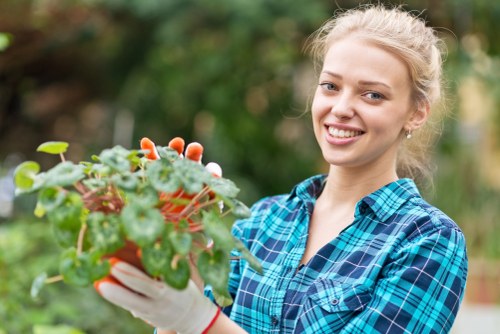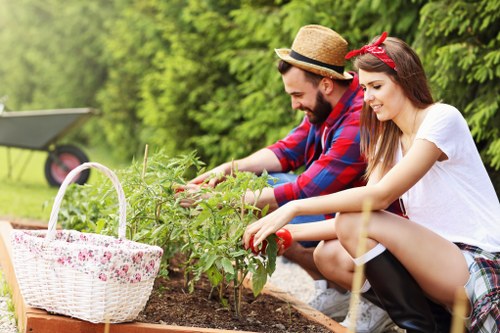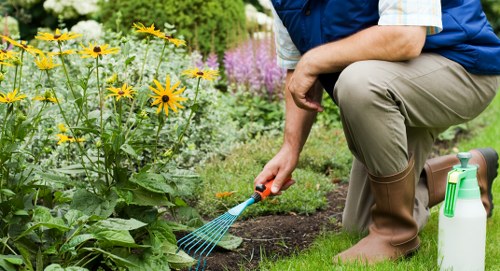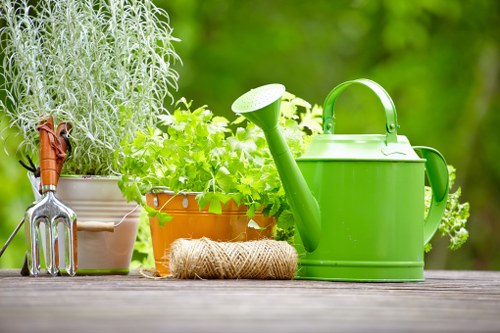Garden Maintenance in Lower Plenty

Introduction to Garden Maintenance
Maintaining a beautiful garden in Lower Plenty requires dedication, knowledge, and the right resources. Whether you're a seasoned gardener or a beginner, understanding the unique aspects of gardening in this region can help you achieve a lush and thriving outdoor space.
Lower Plenty offers a diverse climate and soil conditions that influence plant growth. Proper garden maintenance ensures that your plants remain healthy, vibrant, and resilient against local weather patterns.
In this article, we will explore essential tips and strategies for effective garden maintenance in Lower Plenty.

Seasonal Garden Care
Spring Maintenance
Spring is a crucial time for garden maintenance. Begin by clearing any debris from the winter months, such as fallen leaves and dead branches. This helps prevent disease and pests from taking hold.
Planting new flowers, shrubs, and vegetables can give your garden a fresh start. Choose native plants that are well-suited to Lower Plenty’s climate to ensure better growth and easier maintenance.
Don’t forget to fertilize your soil. Adding compost or organic fertilizers enriches the soil, providing essential nutrients for your plants.

Summer Care
During the summer months, consistent watering is vital. Lower Plenty can experience hot and dry spells, so ensure your garden receives adequate moisture without overwatering.
Mulching is another effective practice. It helps retain soil moisture, regulate temperature, and suppress weed growth.
Regular pruning and deadheading flowers encourage continuous blooming and maintain the overall shape of your plants.

Autumn Preparation
As temperatures begin to drop, prepare your garden for the cooler months. Remove spent plants and clean up garden beds to reduce the risk of pests and diseases overwintering.
Planting bulbs for spring flowering ensures that your garden will be colorful when the warmer weather returns.
Protect sensitive plants by adding mulch or using frost covers to shield them from early frosts.

Winter Maintenance
Winter is a time for reflection and planning. Assess your garden’s performance over the past year and identify areas for improvement.
Prune trees and shrubs to remove any damaged or diseased branches. This promotes healthy growth in the spring.
Ensure that all garden tools are cleaned and stored properly to extend their lifespan and maintain their effectiveness.
Essential Garden Maintenance Tips
Effective garden maintenance involves several key practices. Here are some tips to keep your garden in top condition:
- Regular Weeding: Keep weeds under control to prevent them from competing with your plants for nutrients and water.
- Pest Management: Monitor your garden for pests and diseases regularly. Use organic or chemical treatments as necessary to protect your plants.
- Soil Health: Test your soil periodically and amend it as needed to maintain the right pH and nutrient levels.
- Pruning: Regular pruning helps maintain plant health and encourages vigorous growth.
- Watering: Develop a consistent watering schedule that meets the needs of your plants without causing waterlogging.
Choosing the Right Plants for Lower Plenty
Selecting plants that thrive in Lower Plenty’s environment is crucial for a successful garden. Consider the following factors when choosing your plants:
- Climate: Opt for plants that are well-suited to the local climate, including temperature ranges and precipitation patterns.
- Soil Type: Understand your soil’s composition and choose plants that can thrive in those conditions.
- Sunlight Exposure: Ensure that your plants receive the appropriate amount of sunlight, whether they prefer full sun, partial shade, or full shade.
- Water Requirements: Match plants with similar water needs to simplify your watering routine.
- Maintenance Level: Consider how much time and effort you can dedicate to maintaining each plant.
Irrigation Systems for Efficient Water Use
Implementing an efficient irrigation system can save time and water while ensuring your garden remains healthy. Here are some options:
- Drip Irrigation: Delivers water directly to the plant roots, reducing evaporation and water waste.
- Sprinkler Systems: Suitable for lawns and larger garden areas, providing even water distribution.
- Soaker Hoses: Ideal for vegetable gardens and flower beds, allowing water to seep slowly into the soil.
- Automated Timers: Schedule watering times to maintain consistency and reduce manual effort.
Pest and Disease Management
Protecting your garden from pests and diseases is essential for maintaining plant health. Adopt an integrated pest management (IPM) approach to minimize the impact:
- Monitoring: Regularly inspect plants for signs of pests or disease.
- Prevention: Choose disease-resistant plant varieties and practice good garden hygiene.
- Control: Use biological controls, such as beneficial insects, or apply appropriate pesticides when necessary.
- Cultural Practices: Rotate crops and avoid overcrowding plants to reduce the risk of disease spread.
Soil Health and Fertilization
Healthy soil is the foundation of a thriving garden. Enhance your soil’s fertility and structure with these practices:
- Composting: Recycle garden and kitchen waste into nutrient-rich compost to enrich the soil.
- Mulching: Apply organic mulch to improve soil moisture retention and add nutrients as it decomposes.
- Cover Crops: Plant cover crops like clover or rye to prevent soil erosion and add organic matter.
- Soil Testing: Conduct regular soil tests to determine nutrient levels and pH, adjusting as needed.
Pruning and Trimming Techniques
Proper pruning and trimming promote plant health and aesthetics. Follow these guidelines:
- Timing: Prune during the appropriate season for each plant type to avoid damaging growth.
- Tools: Use sharp, clean tools to make precise cuts and reduce the risk of infection.
- Technique: Remove dead or diseased branches first, then shape the plant to encourage airflow and sunlight penetration.
- Pruning Amount: Avoid over-pruning, which can stress plants and reduce fruit or flower production.
Maintaining Lawn Health
A healthy lawn enhances the overall appearance of your garden. Implement these maintenance tips:
- Mowing: Keep the grass at the recommended height for its type, and mow regularly to promote even growth.
- Watering: Water deeply and infrequently to encourage deep root growth.
- Fertilizing: Apply lawn fertilizers based on soil test recommendations to provide essential nutrients.
- Aerating: Aerate the soil annually to improve air and water penetration.
- Weed Control: Remove weeds promptly and consider pre-emergent herbicides to prevent their growth.
Garden Tools and Equipment
Having the right tools is essential for efficient garden maintenance. Invest in quality equipment that suits your gardening needs:
- Hand Tools: Includes trowels, pruners, and gardening gloves for detailed work.
- Power Tools: Such as lawnmowers, trimmers, and blowers for larger tasks.
- Watering Equipment: Like hoses, sprinklers, and watering cans to ensure proper hydration.
- Soil Testing Kits: To monitor and manage soil health effectively.
- Storage Solutions: Keep tools organized and protected from the elements.
Local Garden Services in Lower Plenty
If you prefer professional assistance, numerous garden maintenance services operate in Lower Plenty. These experts offer a range of services tailored to your garden’s specific needs, from regular upkeep to specialized landscaping projects.
Hiring local professionals ensures that your garden receives personalized care, leveraging their knowledge of the local climate and soil conditions.
Consider scheduling regular maintenance visits or one-time services to keep your garden in optimal condition year-round.
Nearby Areas to Lower Plenty
Lower Plenty is surrounded by several neighborhoods that share similar gardening needs and offer unique features. Here are the closest areas:
- Watsonia: Known for its community gardens and green spaces.
- Eltham North: Offers a mix of residential and garden-focused properties.
- Greensborough: Features extensive parks and well-maintained gardens.
- Bundoora: Home to botanical gardens and diverse plant species.
- Diamond Creek: Offers riverside gardening opportunities and lush landscapes.
- Montmorency: Known for its historic homes and well-preserved gardens.
- Yan Yean: Features large lots suitable for expansive gardens.
- Templers Hill: Offers a mix of native and exotic plant varieties.
- Mill Park: Home to community nurseries and gardening clubs.
- Donnybrook: Features modern gardens with innovative designs.
- Plenty: Known for its vibrant flower beds and decorative plants.
- Macleod: Offers trendy garden layouts and contemporary plantings.
- Reservoir: Features a range of garden styles from traditional to modern.
- Fawkner: Known for its sustainable gardening practices and eco-friendly plants.
- Thornbury: Offers eclectic gardens with a mix of plant species.
Enhancing Your Garden’s Aesthetic
Aesthetics play a significant role in garden maintenance. Here are some ideas to enhance the beauty of your garden:
- Plant Variety: Incorporate a mix of colors, textures, and heights to create visual interest.
- Pathways: Design pathways using natural materials like stone or gravel to add structure.
- Water Features: Add ponds, fountains, or birdbaths to introduce soothing sounds and attract wildlife.
- Lighting: Use garden lights to highlight key areas and extend your garden’s usability into the evening.
- Garden Art: Incorporate sculptures, mosaics, or decorative planters to personalize your space.
Sustainable Gardening Practices
Adopting sustainable practices not only benefits the environment but also improves your garden’s health. Consider these approaches:
- Rainwater Harvesting: Collect rainwater for irrigation to reduce water usage.
- Composting: Recycle organic waste into nutrient-rich compost for your plants.
- Native Plants: Use native species that require less water and are more resistant to local pests.
- Organic Fertilizers: Opt for natural fertilizers to avoid chemical runoff and soil degradation.
- Pollinator Gardens: Plant flowers that attract bees, butterflies, and other pollinators to support biodiversity.
Conclusion
Maintaining a garden in Lower Plenty is a rewarding endeavor that enhances your living space and contributes to the local ecosystem. By following these maintenance tips and embracing sustainable practices, you can cultivate a vibrant and healthy garden throughout the year.
Whether you choose to care for your garden yourself or enlist the help of local professionals, consistent maintenance is key to achieving the garden of your dreams.
Contact us today to schedule your garden maintenance service and transform your outdoor space into a lush, thriving paradise.
Get In Touch
Please fill out the form below to send us an email and we will get back to you as soon as possible.
Telephone:
Opening Hours: Monday to Sunday, 00:00-24:00
Website: allansgardeners.com
Description:
Affordable, expert gardening services for your home or business. Lawn care, design, and maintenance across Australia.
Copyright © Allans Gardeners. All Rights Reserved.
